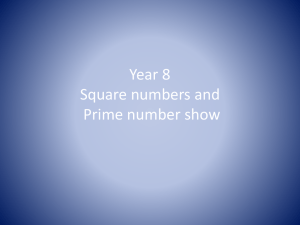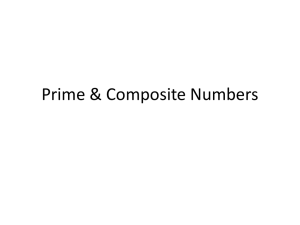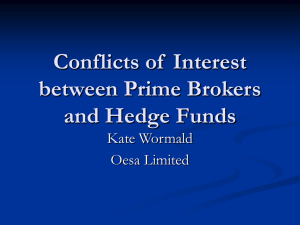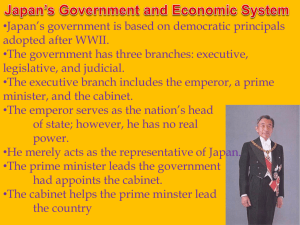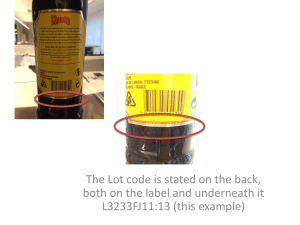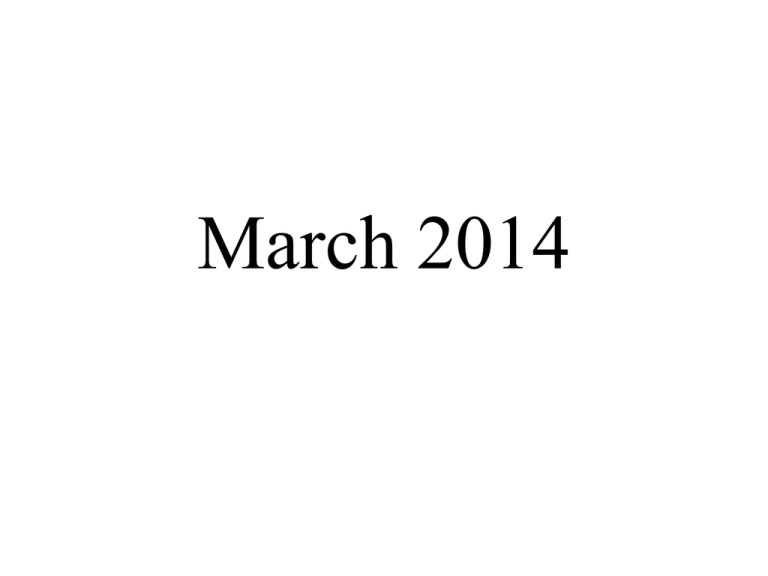
March 2014
PATTERNS
vs
INVARIANTS
142857
142857
2 × 142857 = 285714
142857
2 × 142857 = 285714
3 × 142857 = 428571
142857
2 × 142857 = 285714
3 × 142857 = 428571
4 × 142857 = 571428
142857
2 × 142857 = 285714
3 × 142857 = 428571
4 × 142857 = 571428
5 × 142857 = 714285
142857
2 × 142857 = 285714
3 × 142857 = 428571
4 × 142857 = 571428
5 × 142857 = 714285
6 × 142857 = 857142
142857
2 × 142857 = 285714
3 × 142857 = 428571
4 × 142857 = 571428
5 × 142857 = 714285
6 × 142857 = 857142
7 × 142857 = 999999
1
0.142857142857...
7
Black Holes
Give me any whole number
(# of even digits)(# of odd digits)(total number of digits)
Repeat process
For Example: 19500723
19500723 → # of even digits = 3
# of odd digits = 5
Total # of digits = 8
358 → 123
22221111 → 448 → 303 → 123
22222222 → 808 → 303 → 123
WHY ?
ooe –––> 123
oeo –––> 123
eoo –––> 123
eee –––> 303 –––> 123
201320142015
→ 7512
→ 134
→ 123
Take any 3-digit number.
Rearrange it: Largest – Smallest
674: 764 – 467 = 303
303: 330 – 033 = 297
297: 972 – 279 = 693
693: 963 – 369 = 594
594: 954 – 459 = 495
738 873 – 378 = 495
954 – 459 = 495
215 512 – 125 = 396
963 – 369 = 594
954 – 459 = 495
123 321 – 123 = 198
981 – 189 = 792
972 – 279 = 693
963 – 369 = 594
954 – 459 = 495
1. What is so special about 495?
2. Is there any 3–digit number does not fall into
this black hole?
3. Is there an upper limit of number of steps to
get to this black hole?
4. Is there any type of numbers require more
steps than other types?
5. Is there a black hole for 2–digit numbers?
What about 4-digit numbers?
What about 5-digit numbers?
What about 6-digit numbers?
Is there a pattern?
Take 2–digit numbers.
87: 87 – 78 = 9
90: 90 – 09 = 81
81 – 18 = 63
63 – 36 = 27
72 – 27 = 45
54 – 45 = 9
80: 80 – 08 = 72
72 – 27 = 45
54 – 45 = 9
Is “9” a Black Hole?
Is there any other Black Hole for 2–digit
numbers?
Which 2–digit number takes the longest to reach
the Black Hole?
What about 4–digit numbers?
2341: 4321 – 1234 = 3087
8730 – 0378 = 8352
8532 – 2358 = 6174
7641 – 1467 = 6174
Is 6174 the Black Hole for 4–digit numbers?
What about 5–digit numbers?
12345: 54321 – 12345 = 41976
97641 – 14679 = 82962
98622 – 22689 = 75933
97533 – 33579 = 63954
96543 – 34569 = 61974
97641 – 14679 = 82962
Is 82962 the Black Hole for 5–digit numbers?
Try 22220.
22220: 22220 – 02222 = 19998
99981 – 18999 = 80982
98820 – 02889 = 95931
99531 – 13599 = 85932
98532 – 23589 = 74943
97443 – 34479 = 62964
96642 – 24669 = 71973
97731 – 13779 = 83952
What happened? No Black Hole for 5–digit
numbers?
22220: 22220 – 02222 = 19998
99981 – 18999 = 80982
98820 – 02889 = 95931
99531 – 13599 = 85932
98532 – 23589 = 74943
97443 – 34479 = 62964
96642 – 24669 = 71973
97731 – 13779 = 83952
98532 – 23589 = 74943
However, 74943 is different from 82962. Could it be that
5–digit numbers have more than one Black Holes?
What about 6–digit,
7–digit, …, n–digit
numbers?
1 2 3 4 5 6 7 8 9 10 11 12 13 14 15 16 17 18…
1 2 3 4 5 6 7 8 9 10 11 12 13 14 15 16 17 18…
1 2 3 4 5 6 7 8 9 10 11 12 13 14 15 16 17 18 …
1 2 3 4 5 6 7 8 9 10 11 12 13 14 15 16 17 18 …
1 2 3 4 5 6 7 8 9 10 11 12 13 14 15 16 17 18 …
1 4 9 16 25 36 49 64 81…
1 2 3 4 5 6 7 8 9 10 11 12 13 14 15 16 17 18 …
1 2 3 4 5 6 7 8 9 10 11 12 13 14 15 16 17 18 …
1 4 9 16 25 36
49
64
81…
1
1
1
1
2 3 4 5 6 7 8 9 10 11 12 13 14 15 16 …
2 3 4 5 6 7 8 9 10 11 12 13 14 15 16 …
3 7 12 19 27 37 48 61 75 91…
8 27
64
125
216…
1 2 3 4 5 6 7 8 9 10 11 12 13 14 15 16 17 18 …
1 2 3 4 5 6 7 8 9 10 11 12 13 14 15 16 17 18 …
1 4 9 16 25 36
49
64
81…
1 2 3 4 5 6 7 8 9 10 11 12 13 14 15 16 …
1 2 3 4 5 6 7 8 9 10 11 12 13 14 15 16 …
1 3 712 19 27 37 48
61 75
91…
1
8 27
64
125
216…
1 2 3 4 5 6 7 8 9 10 11 12 13 14 15 …
1 2 3 4 5 6 7 8 9 10 11 12 13 14 15 …
1 3 6 11 17 24 33 43 54
67 81…
1
4
15 32
65 108
175 256…
1
16
81
256…
Can you generalize this
process and extend it? Is it
th
th
same true for 5 power or 6
power or nth power?
Give me any number n.
Use the following process:
n = odd 3 n +1
n = even n /2
Give me any number n.
Use the following process:
n = odd 3n+1
n = even n/2
n=13…40, 20, 10, 5, 16, 8, 4, 2, 1
n=37…112, 56, 28, 14, 7, 22, 11, 34, 17, 52, 26,
13,…,1
n=101…304, 152, 76, 38, 19, 58, 29, 88, 44, 22,
11,…,1
1. Does it always go to 1?
2. In how many steps?
3. What kind of numbers require more
step?
4. Is there a maximum number of
steps?
5. Is there a pattern to the number of
steps required?
1=0
2=1
3=7
4=2
5=5
6=8
7 = 16
8=3
9 = 19
10 = 6
1=0
2=1
3=7
4=2
5=5
6=8
7 = 16
8=3
9 = 19
10 = 6
11 = 14
12 = 9
13 = 9
14 = 17
15 = ?
16 = 4
17 = 12
18 = 20
19 = ?
20 = 7
21 = 6
22 = 15
23 = ?
24 = 10
25 = ?
26 = 10
27 = ?
28 = 18
29 = 17
30 = ?
199 is a prime
Rearrange 199 into 919 (a prime).
Rearrange 199 into 991 (a prime).
199 is called a “Permutable” or
“Absolute” prime
How many permutable primes?
1-digit:
2-digit:
3-digit:
1-digit: 4 (2, 3, 5, 7)
2-digit: 9 (11, 13, 17, 31, 37, 71, 73, 79, 97)
5 (11, 13, 17, 37, 79)
3-digit: 8 (113, 131, 199, 311, 337, 733, 919, 991)
3 (113, 199, 337)
19-digit: 1 (R19 = 11111…111)
23-digit: 1 (R23)
317-digit: 1 (R317)
1031-digit: 1 (R1031)
Facts about Permutable Primes:
1. Must compose from digits 1, 3, 7, and 9 if it is
not 1-digit.
2. There are no permutable primes with number of
digits3 < n < 6×10175 except those that are
composed all 1’s. (Not Proven)
3. There are no permutable primes with only digit 1
other than what are listed in the previous
slide.(Not Proven)
Facts about Permutable Primes:
4. No permutable prime exists which contains 3
different numbers of the 4 digits 1, 3, 7, 9.
(For example: 731 = 17 × 43)
5. No permutable primes that are composed of 2 or
more of each of the 4 digits 1, 3, 7, 9.
“Unprimable” Numbers
= A composite number that changes
any digit and still composite.
What is the smallest “unprimable” number?
Example: 200
For many generations, prime numbers
have always had mystical and magical
appeals to mathematicians. Dating back
to Euclid’s days, he had already proved
that there are infinitely many prime
numbers. However, from what we had
seen before, it is very difficult to prove
even some of the simple properties about
prime numbers.
1. There are infinitely many prime
numbers (Proved by Euclid
about 2000 years ago).
2. There are infinitely many twin
prime numbers (still not yet
proved).
3. There is always at least one prime
number exists between n and 2n
where n is a natural number larger
than 1. (Proved in 1850 by Chebyshev
but he used very difficult and deep
mathematics in his proof. However,
Erdos, the second most prolific
mathematicians in history, used a very
simply proof to prove this result when
he was a freshman in college.)
There are some numbers that
are comparable to prime
numbers. The great late Indian
mathematician Ramanujan had
considered some numbers
called “highly composite”
numbers.
Prime numbers have the minimum
number of factors…only two…1
and itself.
Highly composite numbers have
the maximum number of factors.
Prime numbers have the minimum number of
factors…only two…1 and itself.
Highly composite numbers have the maximum
number of factors.
A composite number is Highly Composite if it
has more distinct factors than any composite
numbers before it.
4 has 3 distinct factors.
6 has 4 distinct factors.
8 has 4 distinct factors.
9 has 3 distinct factors.
10 has 4 distinct factors.
4 has 3 distinct factors…. Yes
6 has 4 distinct factors…. Yes
8 has 4 distinct factors…. No
9 has 3 distinct factors…. No
10 has 4 distinct factors…. No
What about 12?
12 has 6 distinct factors …. Yes
What is the next highly composite
number?
24 has 8 distinct factors ….
Yes
What is the next highly
composite number?
36 has 9 distinct factors …. Yes
Ramanujan made a list of all
highly composite numbers up to
6,746,328,388,800. He examined
the highly composite numbers
expressed as product of primes.
For instance:
4 = 22
1
1
6=2 x3
2
1
12 = 2 x 3
24 = 23 x 31
2
2
36 = 2 x 3
4 = 22
6 = 21 x 31
12 = 22 x 31
24 = 23 x 31
36 = 22 x 32
He discovered that the final exponent of all highly composite
numbers, except for 4 and 36, is 1. Also, in the prime
factorization of any highly composite number, the first exponent
always equals or exceeds the second exponent and the second
always equals or exceeds the third, and so on.
For example:
332,640 = 25 x 33 x 51 x 71 x 111
43,243,200 = 26 x 33 x 52 x 71 x 111 x 131
2,248,776,129,600 = 26 x 33 x 52 x 72 x 111
x 131 x 171 x 191 x 231
He wrote his thesis on the proof of this to
get his college degree from Cambridge.
Pythagoras had considered a
category of numbers with very
interesting properties that are
either very difficult to prove or
not yet proven….“friendly
numbers”.
220 and 284
Factors of 220 = 1, 2, 4, 5, 10, 11,
20, 22, 44, 55, 110 with a sum of
284.
Factors of 284 = 1, 2, 4, 71, 142
with a sum of 220.
This was discovered about 2000
years ago by Greeks. The next
pair did not get discovered until
1636 by Fermat.
17,296 and 18,416.
The second smallest pair of
friendly numbers was not
discovered until 1866 by a 16
years old Italian schoolboy.
1184 and 1210.
Now, with the help of some
powerful computers, hundreds of
pair of friendly numbers had been
discovered.
Question: Are there infinitely
many pairs of friendly numbers
existed? Not yet proven.
More Patterns.
What is so important about
n2+n+17 ?
n2+n+17
n=1
n=2
n=3
n=4
12+1+17 = 19
22+2+17 = 23
32+3+17 = 29
42+4+17 = 37
a prime
a prime
a prime
a prime
n=5
n=6
n=7
n=8
n=9
n=10
n=11
n=12
52+5+17 = 47
62+6+17 = 59
72+7+17 = 73
82+8+17 = 89
92+9+17 = 107
2
10 +10+17 = 127
2
11 +11+17 = 149
2
12 +12+17 = 173
a prime
a prime
a prime
a prime
a prime
a prime
a prime
a prime
You may be tempted to think that you
have found a formula that produces only
prime numbers.
n=13
n=14
n=15
n=16
n=17
132+13+17 = 199
142+14+17 = 227
152+15+17 = 257
162+16+17 = 289
172+17+17 = 323
a prime
a prime
a prime
a prime???
a prime???
Of course, if you use logic plus
patterns, you will see that
n2+n+17 = (17m)2+(17m)+17 =
= 17(17m2+m+1)
not a prime
when n is a multiple of 17
such as 17m. So 323 = (17)(19)
Euler came up with another
2
formula n +n+41. It produces
prime numbers from n=1 to 39
but it fails at n = 40 and 41.
However, people proved that this
formula is actually quite good
generating prime numbers under
10 million a respectable 47.5% of
the time.
28 ÷ 7 = ?
28 ÷ 7 = 13
13
7 | 28
7
21
21
Check:
13
x 7
21
7
28
Another check by adding:
13
13
13
13
13
13
+ 13
Peasant’s Multiplication
37 × 28 = 1036
37
18
9
4
2
1
28
56
112
224
448
896
37 × 28 = 28 + 112 + 896 = 1036
Why does it work?
28 = 111002 = 1×24 + 1×23 + 1×22 + 0×21 + 0×20
37 = 1001012 = 1×25 + 0×24 + 0×23 + 1×22 + 0×21 + 1×20
= 32 + 4 + 1
37
18
9
4
2
1
28
56
112
224
448
896
20 × 28
22 × 28
25 × 28
37 × 28 = (32 + 4 + 1) × 28 = (25 + 22 + 20) × 28 = 896 + 112 + 28) = 1036
What is the sum
of all three angles
of any triangle?
What is the sum
of all three angles
of any triangle?
180°
What is the sum
of all four angles
of any
quadralateral?
What is the sum of
all four angles of
any quadralateral?
360°
What is the sum
of all five angles
of any pentagon?
What is the sum
of all five angles
of any pentagon?
540°
In general, what
is the sum of all n
angles of any
n-polygon?
In general, what
is the sum of all n
angles of any
n-polygon?
In general, what is
the sum of all n
angles of any
n-polygon?
180(n–2)°
How do you
prove that?
180(n–2)°
Interior angle
vs
Exterior angle
What is the sum
of all three
exteror angles of
any triangle?
What is the sum
of all n exterior
angles of any
n-polygon?
New Project:
Best way to build a
high speed rail train to
go from San Francisco
to New York.
It takes about 42
minutes to go
from anywhere to
anywhere.
Suppose there are 2 points on a plane. Can you
find a line that separates these two points?
Suppose there are 3 points on a plane. Can you
find a line that has the same number of points on
either side?
Suppose there are 10 points.
Suppose there are 11 points.
What if there are
2,000,000 points?
What if there are 2,000,000
points in 3–space? Can we
find a plane that separates
them into 2 sets of
1,000,000 each?
Monte Hall’s
“Let’s Make a Deal”
Problem
Behind three doors.
One of them has a car
and each of the other
two has a goat. You
chose Door #1.
If the host asks you if
you want to change
your mind and switch
your choice to another
door, would you?
If the host opens the other two
doors and shows you that
there is a goat behind each of
these two doors and asks you
if you want to change your
mind and switch your choice
to another door, would you?
If the host opens the one of the
other two doors and shows
you that there is a goat behind
that door and asks you if you
want to change your mind and
switch your choice to another
door, would you?
Not Switch
#1
#2
#3 Outcome
Car Goat Goat Win
Goat Car Goat Lose
Goat Goat Car Lose
Probability of winning = 1/3
Switch
#1
#2
#3 Outcome
Car Goat Goat Lose
Goat Car Goat Win
Goat Goat Car Win
Probability of winning = 2/3
Another problem.
During the old days, when people look up on the sky
and see 8 stars lining up on a straight line, they think
that special phenomenon must be set up artificially
on purpose. The former great astronomer Carl Sagan
said that this is really nothing special about it. He
pointed out that, actually, if you have looked at larger
enough of a sample, that phenomenon of 8 stars
lining up happens everywhere. He is actually
speaking of a very special topic in mathematics (one
which is very popular among math competition
problems).
Example.
Pick any two students here. You may
find one boy and one girl. As you keep
picking out two students many times
and suddenly you see both of the
students are of the same sex. You are
so amazed about this find that you
proclaimed that someone must have
done this for a purpose.
However, upon examining this, you
find that if you widen your pick …
picking 3 students at a time, then the
phenomenon of having two students
of the same gender is nothing special.
In fact, every time you do your pick of
3 students, two students of the same
gender are among your pick.
So picking 3 students at a time is the
smallest number of students you can pick
to guarantee this phenomenon happened.
The first person who formalize this theory
and process is Frank Ramsey who died in
1930 at the age of 26. We now called this
theory the Ramsey Theory in honor of
him. It turns out problems from Ramsey
Theory are some of the most difficult
problems in mathematics.
Here is a classical Ramsey problem.
What is the minimum number of
guests that need to be invited so that
either at least 3 guests will know
each other or at least 3 will be
mutual strangers?
Obviously a party of 3 is not
enough.
Obviously a party of 3 is not
enough.
A–B C
A party of 4 is also not enough.
A party of 4 is also not enough.
A–B–C–D
A party of 5 is not enough.
A party of 5 is not enough.
A–B–D
\
/
C–E
A party of 6 is enough.
Either A knows at least three of
the other five or A does not know
at least three of the other five.
/
B
Assume A knows B and C and D. A –– C
\D
If B–C or C–D or B–D, then either ABC or ACD or ABD know each
other.
If not, then B, C, and D are total strangers.
Assume A does not know B and C and D.
If B does not know C or C does not know D or B
does not know D, then ABC or ACD or ABD are
totally strangers.
If B knows C and D and C knows D, BCD know
each other.
If B knows C and D but C does not know D, then
ACD are totally strangers.
Another way to prove this is to list and
examine all the combinations of relationships
between those 6 people. It turns out these are
a total of 32,768 possibilities. This brute force
method does not provide any insight.
Now if we increase the number of 3 persons
to 4, brute force method is impossible to do
because the large number of possibilities.
It has been proved that at least 18 people need
to be invited to guarantee at least 4 persons all
know each other or all strangers.
What about 5? Nobody knows. People think
the least number is between 43 and 49.
What about 6? People think the least
number is between 102 and 165.
One of the largest doing with
computers to solve math problems
occurred in 1993 involving 110
computers running simultaneously to
show that the minimum number of
guests to invite to a party to
guarantee at least 4 mutual friends or
at least 5 mutually strangers is 25.
π
π ≈ 3.1415926535897…
π
π ≈ 3.1415926535897…
Pi Day:
March 14, 2015 9:26:53 morning.
Facts About π
1. π was calculated to over 10 trillion digits (1013).
2. Record for most number of digits memorized is over
67,000.
3. π is irrational (1761).
4. π is transcendental (1882).
5. π is NOT normal – all possible sequence of digits
appear equally often. That means one can use the
digits from π to form random numbers (not proven).
6. A sequence of six consecutive 9’s appeared begins at
the 762nd decimal place (Feynman Point).
Facts About π
Six 9’s starts at 762.
Next six 9’s starts at 193,034.
Six 8’s starts at 222,299.
Six 0’s starts at 1,699,927.
Six 6’s starts at 45,681,781.
One 9 – 5
Two 9’s – 44
Three 9’s – 762
Four 9’s – 762
Five 9’s – 762
Six 9’s – 762
Seven 9’s – 1,722,776
Eight 9’s – 36,356,642
Nine 9’s – 564,665,206
Joe’s Accomplishments
Joe lived over 1550 years ago.
Joe calculated 3.1415926 < π < 3.1415927
Joe used two fractions to approximate π
22/7 = 3.142857143… as coarse ratio
355/113 = 3.14159292035… as refined ratio
22/7 was used 2000 years ago by Greek’s Archimedes
Archimedes also calculated
223/72 < π < 22/7
3.140845… < π < 3.142857…
By slight increase to the denominators from 7 and 72 to Joe’s
113, π’s accuracy increases from 2 to 6 decimals
What So Good About 355/113?
1. |31415926/10000000 – π| < 0.00000005
gets 7 decimal accuracy.
31415926/10000000 = 15707963/5000000 gets only 1
more decimal accuracy than 355/113, but 5,000,000 is
so much larger than 113.
2. Any fraction with denominator less than 113 cannot get a
better approximation of π.
3. Any fractional approximation of π with denominator less
than 1000 cannot get better estimate than 113
What So Good About 355/113?
4. Even denominator less than 10000 cannot get
better estimate than 113
5. In fact, any denominator less than 16604
cannot be better.
What so good about 355/113?
Why 113 Is So Good?
Let us try to find a fraction q/p ≠ 355/113 but
gives about the same or better estimate.
0 < 355/113 – π < 0.00000026677
–0.00000026677 < π – q/p < 0.00000026677
Add
–0.00000026677 < 355/113 – q/p < 2×0.00000026677
|355/113 – q/p| = |(355p–113q)/113p|
< 2×0.00000026677
Since q/p ≠ 355/113, so |355p – 113q| > 0.
But p & q are integers, so |355p–113q| > 1.
So, 1/113p ≤ |(355p–113q)/113p|
< 2×0.00000026677
p > 1/(113×2×0.00000026677) > 16586.
In fact, 52163/16604 = 3.141592387…
355/113 = 3.1415922035…
π = 3.1415926535897…
Using 16604 gives us 6 decimal accuracy just
like 113 but 16604 is more than 100 times
larger than 113
How Did Joe Get 355/113?
It is a mystery since Joe did not write it down
or publish it on internet.
Let us find one possible way that he could have
done it.
Remember: We are not trying to get a good
estimate for π. We are trying to find a good
fraction to estimate π.
π = 3 + 0.141592653… = 3 + a1 = 3 + 1/(1/ a1)
1/a1 = 1/0.141592653 = 7.062513305… = 7 + a2
So,
π = 3 + a1 = 3 + 1/(1/ a1) = 3 + 1/(7+a2) ≈ 3 + 1/7
= 22/7
1/a2 = 1/0.062513305 = 15.99659454…= 15 + a3
So,
π = 3 + 1/(7+(1/(15+a3))) ≈ 3 + 1/(7+1/15)
= 333/106
1/a3 = 1/0.99659454 = 1.003417097…= 1 + a4
So,
π = 3 + 1/(7+(1/(15+1/(1+a4))))
≈ 3 + 1/(7+1/(15+1)) = 355/113
One More Step:
1/a4 = 1/0.003417097 = 292.6460677…= 292 + a5
So,
π = 3 + 1/(7+(1/(15+1/(1+(292+a5)))))
≈ 3 + 1/(7+1/(15+1/(1+1/292)))
= 103993/33102
However, 103993/33102 = 3.141592653011900…
and
π = 3.1415926535897…
which is 9 decimals accuracy but 33102 is almost
300 times larger than 113.
Also, 355/113 is easy to remember:
113|355
Note that
2 = 1.414213562…
1
= 1
2
1
2
1
1
2
2
And the Golden Ratio is:
ᵠ=
=
1 5
2
1.6180339887…
1
1
=
1
1
1
1
1
1
1
What would be good fractions
to approximate
2
and
ᵠ
Note that
2 = 1.414213562…
=
1
1
2
1
2
1
1
2
2
1, 4/3, 10/7, 24/17, 58/41, 140/99, 338/239,
816/577, …
1+1 = 2
1
4
1
1.33333...
1 2 3
1
10
1
1.42857142857...
4 7
1
3
1
24
1
1.4117647...
10 17
1
7
1
58
1
1.4146341463.....
24 41
1
17
ᵠ = 1.6180339887…
=
1
1
1
1
1
1
1
1
1
1, 3/2, 5/3, 8/5, 13/8, 21/13, 34/21, 55/34, 89/55,
…
1+1 = 2
1 3
1 1.5
2 2
1 5
1 1.66666...
3 3
2
1 8
1 1.6
5 5
3
1 13
1 1.625
8 8
1729
Hardy–Ramanujan Number
3
1
3
12
1729 = +
3
3
= 9 + 10
(1) 1729 is the smallest natural
number that has this
property.
(2) 1729 is a “near–miss” for
n
n
n
z =x +y .
3
3
3
1729 = 12 +1 = 9 + 10
Is there a number that
can be written as the
sum of 4 cubes in at
least 10 different
ways?
It is hard to find such
number but it is
relatively easy to
show that this number
exists.
Note:
There are 1000 cubes that are less
than or equal to 1,000,000,000.
Is there a number that can be
written as the sum of 4 cubes in at
least 10 different ways?
Order the first thousand cubes as
a1, a2, a3, a4, …, a1000.
There are 1000C4 = 1000×999×998×997/24 >
40×1,000,000,000 ways to pick out any 4 cubes
from this sequence.
Any sum of 4 cubes from this sequence cannot
exceed 4×1,000,000,000.
So there are at the most 4,000,000,000 values to
choose from by these more than 40,000,000,000 sets
of sum of 4 cubes. Therefore, there is at least one
value (among these 4,000,000,000) that is equal to 10
or more sets of sum of four cubes.


